An Analysis of Positive Leadership in Organizational Settings
VerifiedAdded on 2021/12/28
|10
|2454
|55
Essay
AI Summary
This essay examines the concept of positive leadership and its significant impact on employee motivation, workplace dynamics, and overall organizational performance. It delves into the strategies employed by positive leaders to foster a healthy and productive work environment, emphasizing the importance of communication, teamwork, and psychological capital. The essay contrasts positive leadership with transformational leadership, highlighting the role of well-being, engagement, and commitment in enhancing employee performance. It also discusses the practical applications of positive leadership, including setting clear goals, developing employee skills, and creating a supportive atmosphere. The essay further explores the relationship between leaders' psychological capital and followers' organizational behavior, and concludes with suggestions for improving workplace dynamics through better communication, teamwork, and employee motivation, ultimately underscoring the importance of positive leadership for achieving organizational success and sustainability. This essay is contributed by a student to be published on the website Desklib, a platform which provides all the necessary AI based study tools for students.

Running Head: POSITIVE LEADERSHIP 0
Positive Leadership
Essay
Student name:
11/21/2018
Positive Leadership
Essay
Student name:
11/21/2018
Paraphrase This Document
Need a fresh take? Get an instant paraphrase of this document with our AI Paraphraser
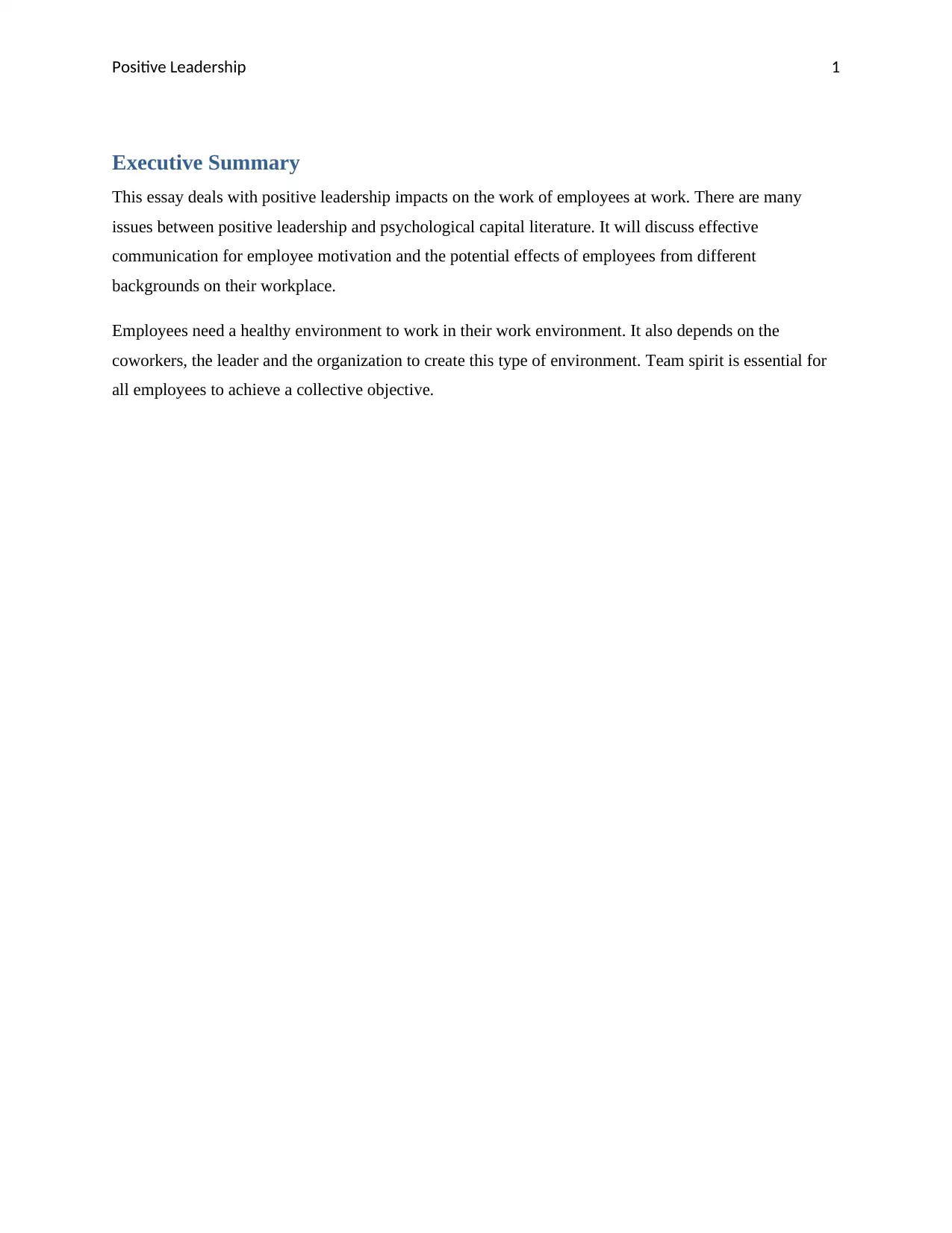
Positive Leadership 1
Executive Summary
This essay deals with positive leadership impacts on the work of employees at work. There are many
issues between positive leadership and psychological capital literature. It will discuss effective
communication for employee motivation and the potential effects of employees from different
backgrounds on their workplace.
Employees need a healthy environment to work in their work environment. It also depends on the
coworkers, the leader and the organization to create this type of environment. Team spirit is essential for
all employees to achieve a collective objective.
Executive Summary
This essay deals with positive leadership impacts on the work of employees at work. There are many
issues between positive leadership and psychological capital literature. It will discuss effective
communication for employee motivation and the potential effects of employees from different
backgrounds on their workplace.
Employees need a healthy environment to work in their work environment. It also depends on the
coworkers, the leader and the organization to create this type of environment. Team spirit is essential for
all employees to achieve a collective objective.
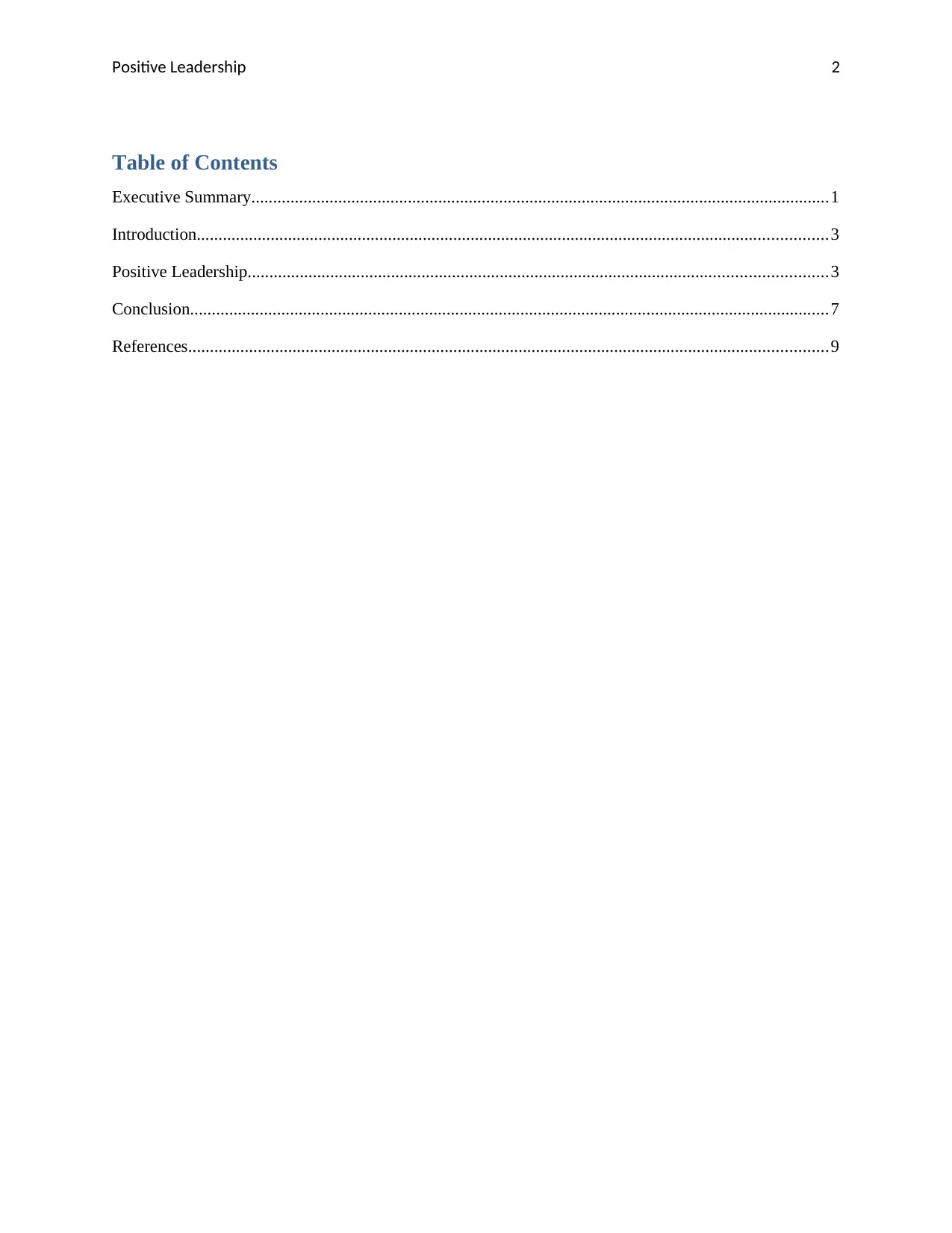
Positive Leadership 2
Table of Contents
Executive Summary.....................................................................................................................................1
Introduction.................................................................................................................................................3
Positive Leadership.....................................................................................................................................3
Conclusion...................................................................................................................................................7
References...................................................................................................................................................9
Table of Contents
Executive Summary.....................................................................................................................................1
Introduction.................................................................................................................................................3
Positive Leadership.....................................................................................................................................3
Conclusion...................................................................................................................................................7
References...................................................................................................................................................9
⊘ This is a preview!⊘
Do you want full access?
Subscribe today to unlock all pages.

Trusted by 1+ million students worldwide
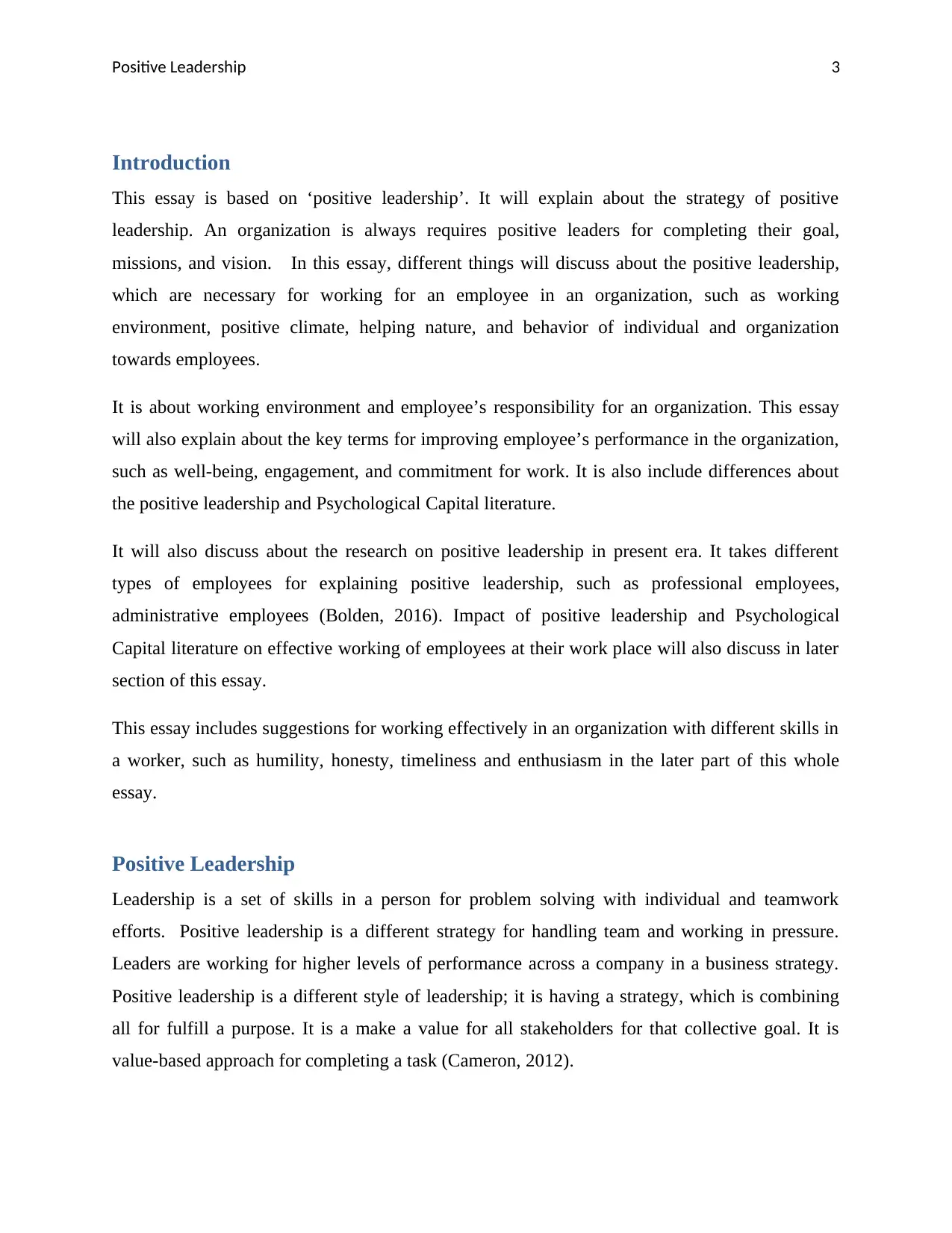
Positive Leadership 3
Introduction
This essay is based on ‘positive leadership’. It will explain about the strategy of positive
leadership. An organization is always requires positive leaders for completing their goal,
missions, and vision. In this essay, different things will discuss about the positive leadership,
which are necessary for working for an employee in an organization, such as working
environment, positive climate, helping nature, and behavior of individual and organization
towards employees.
It is about working environment and employee’s responsibility for an organization. This essay
will also explain about the key terms for improving employee’s performance in the organization,
such as well-being, engagement, and commitment for work. It is also include differences about
the positive leadership and Psychological Capital literature.
It will also discuss about the research on positive leadership in present era. It takes different
types of employees for explaining positive leadership, such as professional employees,
administrative employees (Bolden, 2016). Impact of positive leadership and Psychological
Capital literature on effective working of employees at their work place will also discuss in later
section of this essay.
This essay includes suggestions for working effectively in an organization with different skills in
a worker, such as humility, honesty, timeliness and enthusiasm in the later part of this whole
essay.
Positive Leadership
Leadership is a set of skills in a person for problem solving with individual and teamwork
efforts. Positive leadership is a different strategy for handling team and working in pressure.
Leaders are working for higher levels of performance across a company in a business strategy.
Positive leadership is a different style of leadership; it is having a strategy, which is combining
all for fulfill a purpose. It is a make a value for all stakeholders for that collective goal. It is
value-based approach for completing a task (Cameron, 2012).
Introduction
This essay is based on ‘positive leadership’. It will explain about the strategy of positive
leadership. An organization is always requires positive leaders for completing their goal,
missions, and vision. In this essay, different things will discuss about the positive leadership,
which are necessary for working for an employee in an organization, such as working
environment, positive climate, helping nature, and behavior of individual and organization
towards employees.
It is about working environment and employee’s responsibility for an organization. This essay
will also explain about the key terms for improving employee’s performance in the organization,
such as well-being, engagement, and commitment for work. It is also include differences about
the positive leadership and Psychological Capital literature.
It will also discuss about the research on positive leadership in present era. It takes different
types of employees for explaining positive leadership, such as professional employees,
administrative employees (Bolden, 2016). Impact of positive leadership and Psychological
Capital literature on effective working of employees at their work place will also discuss in later
section of this essay.
This essay includes suggestions for working effectively in an organization with different skills in
a worker, such as humility, honesty, timeliness and enthusiasm in the later part of this whole
essay.
Positive Leadership
Leadership is a set of skills in a person for problem solving with individual and teamwork
efforts. Positive leadership is a different strategy for handling team and working in pressure.
Leaders are working for higher levels of performance across a company in a business strategy.
Positive leadership is a different style of leadership; it is having a strategy, which is combining
all for fulfill a purpose. It is a make a value for all stakeholders for that collective goal. It is
value-based approach for completing a task (Cameron, 2012).
Paraphrase This Document
Need a fresh take? Get an instant paraphrase of this document with our AI Paraphraser
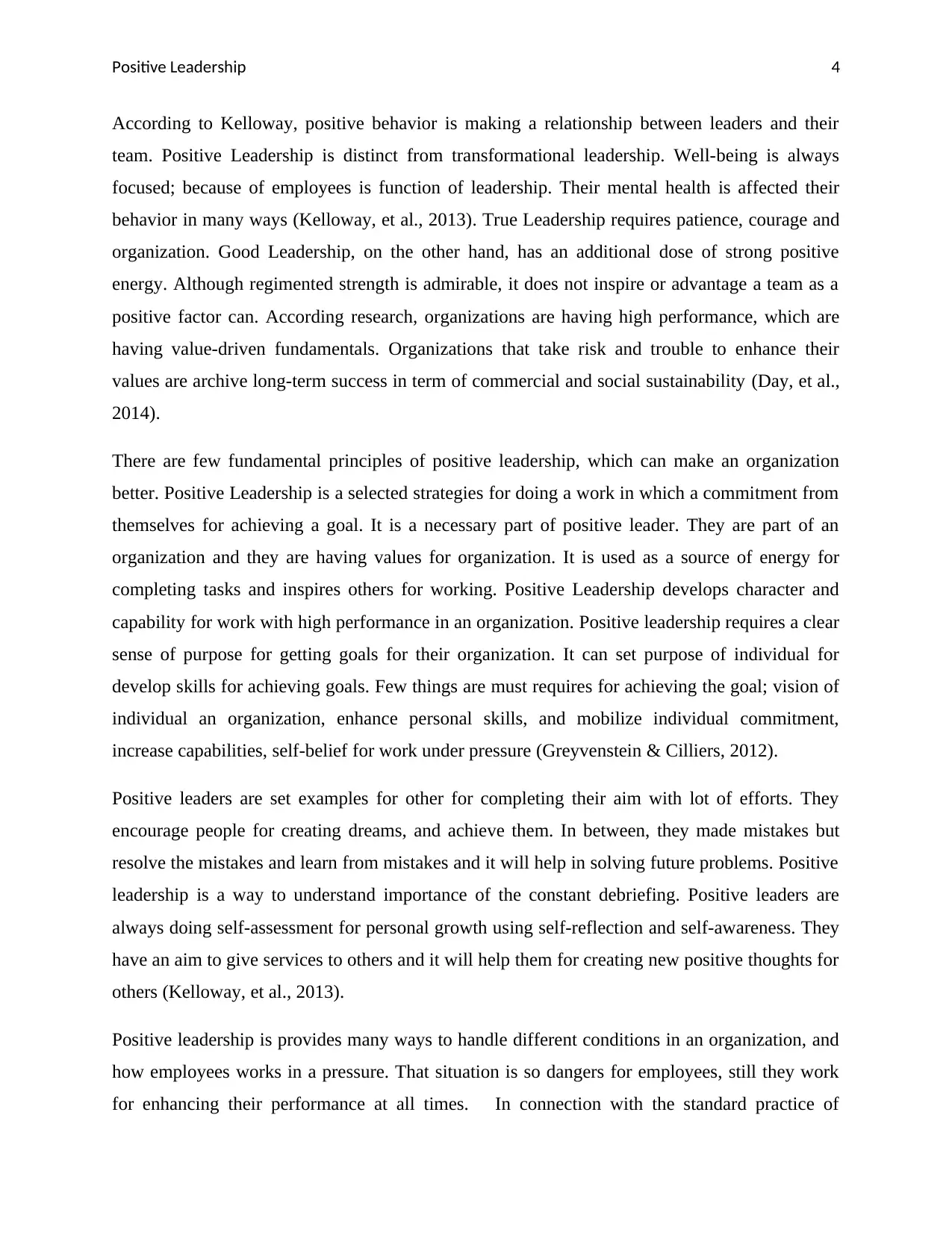
Positive Leadership 4
According to Kelloway, positive behavior is making a relationship between leaders and their
team. Positive Leadership is distinct from transformational leadership. Well-being is always
focused; because of employees is function of leadership. Their mental health is affected their
behavior in many ways (Kelloway, et al., 2013). True Leadership requires patience, courage and
organization. Good Leadership, on the other hand, has an additional dose of strong positive
energy. Although regimented strength is admirable, it does not inspire or advantage a team as a
positive factor can. According research, organizations are having high performance, which are
having value-driven fundamentals. Organizations that take risk and trouble to enhance their
values are archive long-term success in term of commercial and social sustainability (Day, et al.,
2014).
There are few fundamental principles of positive leadership, which can make an organization
better. Positive Leadership is a selected strategies for doing a work in which a commitment from
themselves for achieving a goal. It is a necessary part of positive leader. They are part of an
organization and they are having values for organization. It is used as a source of energy for
completing tasks and inspires others for working. Positive Leadership develops character and
capability for work with high performance in an organization. Positive leadership requires a clear
sense of purpose for getting goals for their organization. It can set purpose of individual for
develop skills for achieving goals. Few things are must requires for achieving the goal; vision of
individual an organization, enhance personal skills, and mobilize individual commitment,
increase capabilities, self-belief for work under pressure (Greyvenstein & Cilliers, 2012).
Positive leaders are set examples for other for completing their aim with lot of efforts. They
encourage people for creating dreams, and achieve them. In between, they made mistakes but
resolve the mistakes and learn from mistakes and it will help in solving future problems. Positive
leadership is a way to understand importance of the constant debriefing. Positive leaders are
always doing self-assessment for personal growth using self-reflection and self-awareness. They
have an aim to give services to others and it will help them for creating new positive thoughts for
others (Kelloway, et al., 2013).
Positive leadership is provides many ways to handle different conditions in an organization, and
how employees works in a pressure. That situation is so dangers for employees, still they work
for enhancing their performance at all times. In connection with the standard practice of
According to Kelloway, positive behavior is making a relationship between leaders and their
team. Positive Leadership is distinct from transformational leadership. Well-being is always
focused; because of employees is function of leadership. Their mental health is affected their
behavior in many ways (Kelloway, et al., 2013). True Leadership requires patience, courage and
organization. Good Leadership, on the other hand, has an additional dose of strong positive
energy. Although regimented strength is admirable, it does not inspire or advantage a team as a
positive factor can. According research, organizations are having high performance, which are
having value-driven fundamentals. Organizations that take risk and trouble to enhance their
values are archive long-term success in term of commercial and social sustainability (Day, et al.,
2014).
There are few fundamental principles of positive leadership, which can make an organization
better. Positive Leadership is a selected strategies for doing a work in which a commitment from
themselves for achieving a goal. It is a necessary part of positive leader. They are part of an
organization and they are having values for organization. It is used as a source of energy for
completing tasks and inspires others for working. Positive Leadership develops character and
capability for work with high performance in an organization. Positive leadership requires a clear
sense of purpose for getting goals for their organization. It can set purpose of individual for
develop skills for achieving goals. Few things are must requires for achieving the goal; vision of
individual an organization, enhance personal skills, and mobilize individual commitment,
increase capabilities, self-belief for work under pressure (Greyvenstein & Cilliers, 2012).
Positive leaders are set examples for other for completing their aim with lot of efforts. They
encourage people for creating dreams, and achieve them. In between, they made mistakes but
resolve the mistakes and learn from mistakes and it will help in solving future problems. Positive
leadership is a way to understand importance of the constant debriefing. Positive leaders are
always doing self-assessment for personal growth using self-reflection and self-awareness. They
have an aim to give services to others and it will help them for creating new positive thoughts for
others (Kelloway, et al., 2013).
Positive leadership is provides many ways to handle different conditions in an organization, and
how employees works in a pressure. That situation is so dangers for employees, still they work
for enhancing their performance at all times. In connection with the standard practice of
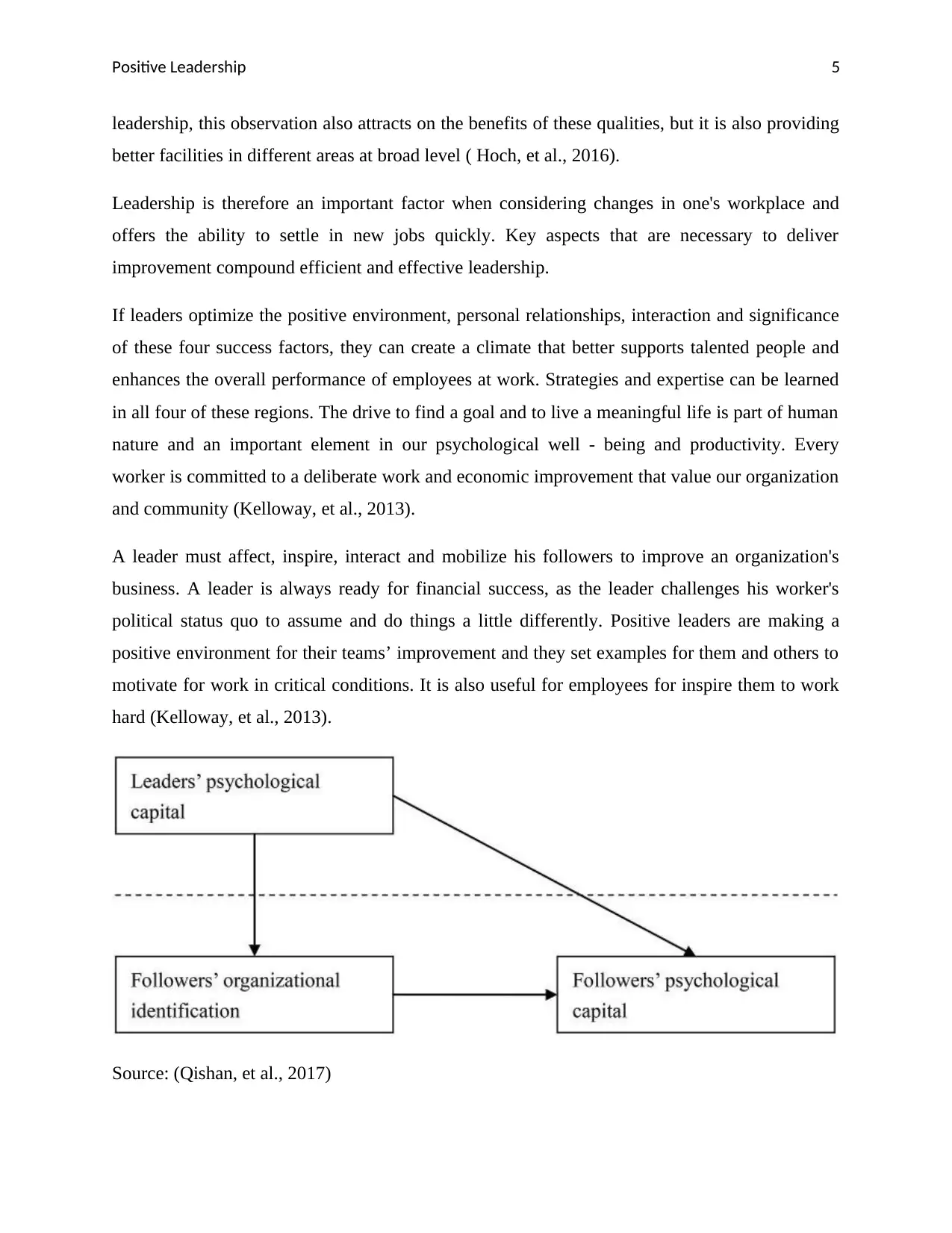
Positive Leadership 5
leadership, this observation also attracts on the benefits of these qualities, but it is also providing
better facilities in different areas at broad level ( Hoch, et al., 2016).
Leadership is therefore an important factor when considering changes in one's workplace and
offers the ability to settle in new jobs quickly. Key aspects that are necessary to deliver
improvement compound efficient and effective leadership.
If leaders optimize the positive environment, personal relationships, interaction and significance
of these four success factors, they can create a climate that better supports talented people and
enhances the overall performance of employees at work. Strategies and expertise can be learned
in all four of these regions. The drive to find a goal and to live a meaningful life is part of human
nature and an important element in our psychological well - being and productivity. Every
worker is committed to a deliberate work and economic improvement that value our organization
and community (Kelloway, et al., 2013).
A leader must affect, inspire, interact and mobilize his followers to improve an organization's
business. A leader is always ready for financial success, as the leader challenges his worker's
political status quo to assume and do things a little differently. Positive leaders are making a
positive environment for their teams’ improvement and they set examples for them and others to
motivate for work in critical conditions. It is also useful for employees for inspire them to work
hard (Kelloway, et al., 2013).
Source: (Qishan, et al., 2017)
leadership, this observation also attracts on the benefits of these qualities, but it is also providing
better facilities in different areas at broad level ( Hoch, et al., 2016).
Leadership is therefore an important factor when considering changes in one's workplace and
offers the ability to settle in new jobs quickly. Key aspects that are necessary to deliver
improvement compound efficient and effective leadership.
If leaders optimize the positive environment, personal relationships, interaction and significance
of these four success factors, they can create a climate that better supports talented people and
enhances the overall performance of employees at work. Strategies and expertise can be learned
in all four of these regions. The drive to find a goal and to live a meaningful life is part of human
nature and an important element in our psychological well - being and productivity. Every
worker is committed to a deliberate work and economic improvement that value our organization
and community (Kelloway, et al., 2013).
A leader must affect, inspire, interact and mobilize his followers to improve an organization's
business. A leader is always ready for financial success, as the leader challenges his worker's
political status quo to assume and do things a little differently. Positive leaders are making a
positive environment for their teams’ improvement and they set examples for them and others to
motivate for work in critical conditions. It is also useful for employees for inspire them to work
hard (Kelloway, et al., 2013).
Source: (Qishan, et al., 2017)
⊘ This is a preview!⊘
Do you want full access?
Subscribe today to unlock all pages.

Trusted by 1+ million students worldwide
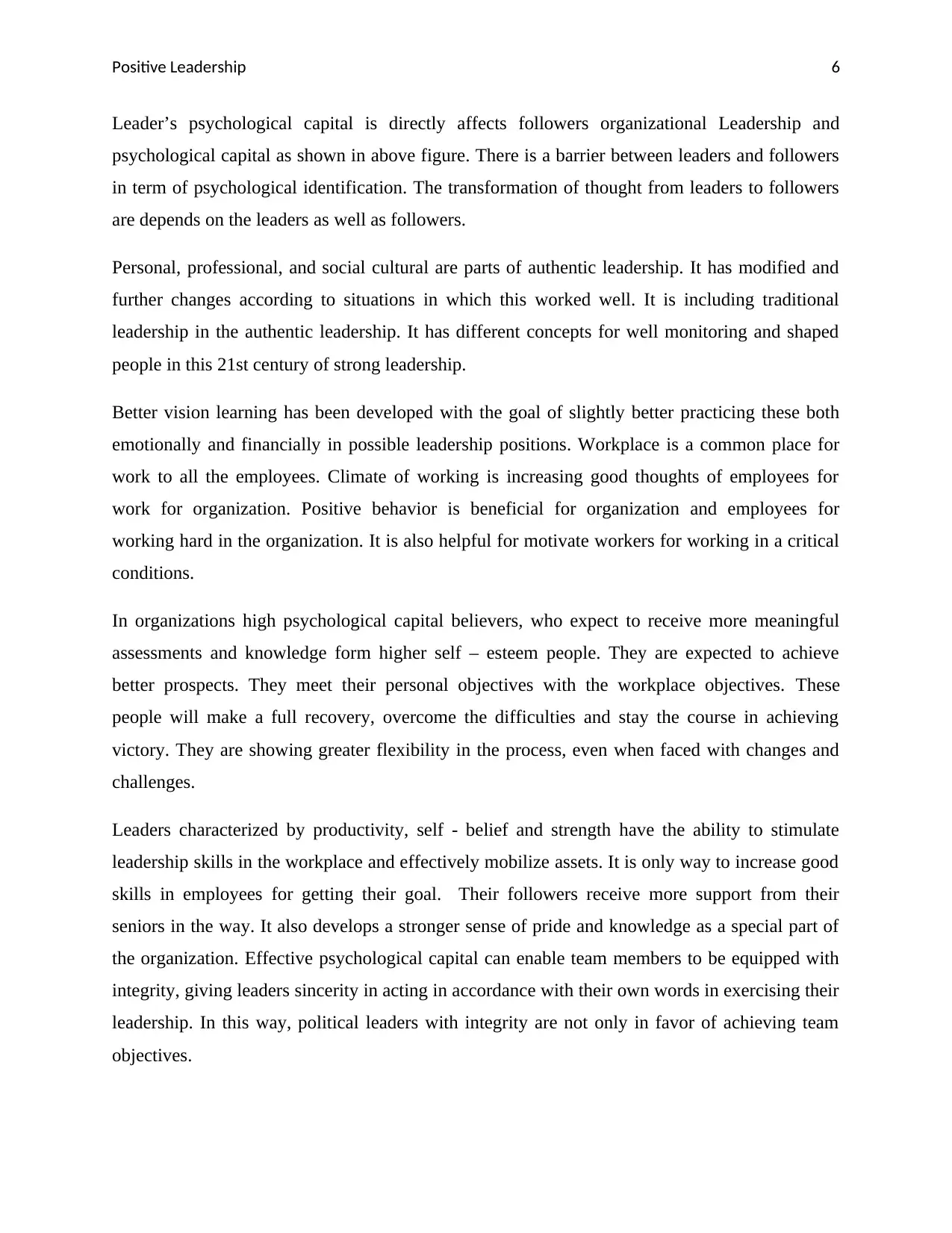
Positive Leadership 6
Leader’s psychological capital is directly affects followers organizational Leadership and
psychological capital as shown in above figure. There is a barrier between leaders and followers
in term of psychological identification. The transformation of thought from leaders to followers
are depends on the leaders as well as followers.
Personal, professional, and social cultural are parts of authentic leadership. It has modified and
further changes according to situations in which this worked well. It is including traditional
leadership in the authentic leadership. It has different concepts for well monitoring and shaped
people in this 21st century of strong leadership.
Better vision learning has been developed with the goal of slightly better practicing these both
emotionally and financially in possible leadership positions. Workplace is a common place for
work to all the employees. Climate of working is increasing good thoughts of employees for
work for organization. Positive behavior is beneficial for organization and employees for
working hard in the organization. It is also helpful for motivate workers for working in a critical
conditions.
In organizations high psychological capital believers, who expect to receive more meaningful
assessments and knowledge form higher self – esteem people. They are expected to achieve
better prospects. They meet their personal objectives with the workplace objectives. These
people will make a full recovery, overcome the difficulties and stay the course in achieving
victory. They are showing greater flexibility in the process, even when faced with changes and
challenges.
Leaders characterized by productivity, self - belief and strength have the ability to stimulate
leadership skills in the workplace and effectively mobilize assets. It is only way to increase good
skills in employees for getting their goal. Their followers receive more support from their
seniors in the way. It also develops a stronger sense of pride and knowledge as a special part of
the organization. Effective psychological capital can enable team members to be equipped with
integrity, giving leaders sincerity in acting in accordance with their own words in exercising their
leadership. In this way, political leaders with integrity are not only in favor of achieving team
objectives.
Leader’s psychological capital is directly affects followers organizational Leadership and
psychological capital as shown in above figure. There is a barrier between leaders and followers
in term of psychological identification. The transformation of thought from leaders to followers
are depends on the leaders as well as followers.
Personal, professional, and social cultural are parts of authentic leadership. It has modified and
further changes according to situations in which this worked well. It is including traditional
leadership in the authentic leadership. It has different concepts for well monitoring and shaped
people in this 21st century of strong leadership.
Better vision learning has been developed with the goal of slightly better practicing these both
emotionally and financially in possible leadership positions. Workplace is a common place for
work to all the employees. Climate of working is increasing good thoughts of employees for
work for organization. Positive behavior is beneficial for organization and employees for
working hard in the organization. It is also helpful for motivate workers for working in a critical
conditions.
In organizations high psychological capital believers, who expect to receive more meaningful
assessments and knowledge form higher self – esteem people. They are expected to achieve
better prospects. They meet their personal objectives with the workplace objectives. These
people will make a full recovery, overcome the difficulties and stay the course in achieving
victory. They are showing greater flexibility in the process, even when faced with changes and
challenges.
Leaders characterized by productivity, self - belief and strength have the ability to stimulate
leadership skills in the workplace and effectively mobilize assets. It is only way to increase good
skills in employees for getting their goal. Their followers receive more support from their
seniors in the way. It also develops a stronger sense of pride and knowledge as a special part of
the organization. Effective psychological capital can enable team members to be equipped with
integrity, giving leaders sincerity in acting in accordance with their own words in exercising their
leadership. In this way, political leaders with integrity are not only in favor of achieving team
objectives.
Paraphrase This Document
Need a fresh take? Get an instant paraphrase of this document with our AI Paraphraser
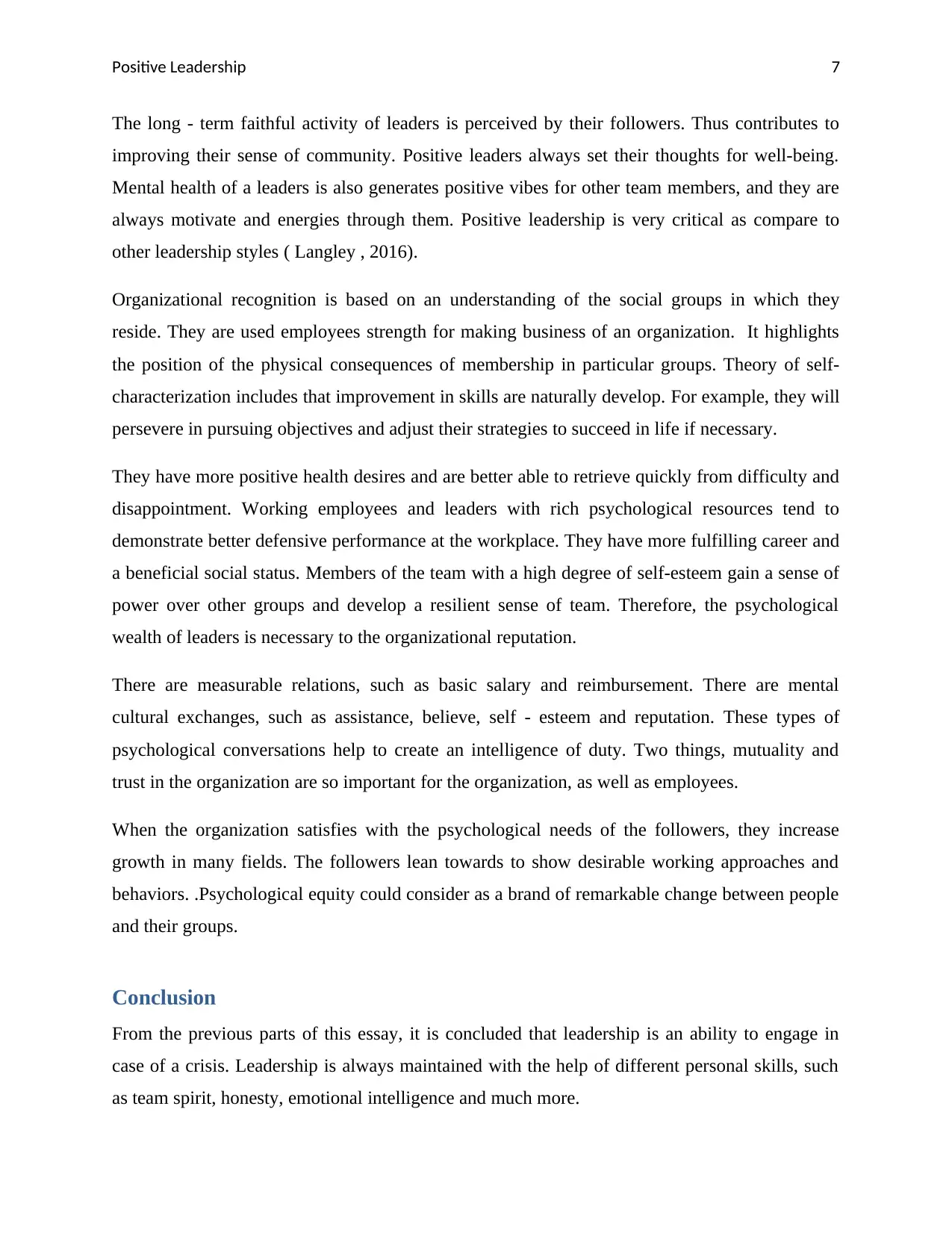
Positive Leadership 7
The long - term faithful activity of leaders is perceived by their followers. Thus contributes to
improving their sense of community. Positive leaders always set their thoughts for well-being.
Mental health of a leaders is also generates positive vibes for other team members, and they are
always motivate and energies through them. Positive leadership is very critical as compare to
other leadership styles ( Langley , 2016).
Organizational recognition is based on an understanding of the social groups in which they
reside. They are used employees strength for making business of an organization. It highlights
the position of the physical consequences of membership in particular groups. Theory of self-
characterization includes that improvement in skills are naturally develop. For example, they will
persevere in pursuing objectives and adjust their strategies to succeed in life if necessary.
They have more positive health desires and are better able to retrieve quickly from difficulty and
disappointment. Working employees and leaders with rich psychological resources tend to
demonstrate better defensive performance at the workplace. They have more fulfilling career and
a beneficial social status. Members of the team with a high degree of self-esteem gain a sense of
power over other groups and develop a resilient sense of team. Therefore, the psychological
wealth of leaders is necessary to the organizational reputation.
There are measurable relations, such as basic salary and reimbursement. There are mental
cultural exchanges, such as assistance, believe, self - esteem and reputation. These types of
psychological conversations help to create an intelligence of duty. Two things, mutuality and
trust in the organization are so important for the organization, as well as employees.
When the organization satisfies with the psychological needs of the followers, they increase
growth in many fields. The followers lean towards to show desirable working approaches and
behaviors. .Psychological equity could consider as a brand of remarkable change between people
and their groups.
Conclusion
From the previous parts of this essay, it is concluded that leadership is an ability to engage in
case of a crisis. Leadership is always maintained with the help of different personal skills, such
as team spirit, honesty, emotional intelligence and much more.
The long - term faithful activity of leaders is perceived by their followers. Thus contributes to
improving their sense of community. Positive leaders always set their thoughts for well-being.
Mental health of a leaders is also generates positive vibes for other team members, and they are
always motivate and energies through them. Positive leadership is very critical as compare to
other leadership styles ( Langley , 2016).
Organizational recognition is based on an understanding of the social groups in which they
reside. They are used employees strength for making business of an organization. It highlights
the position of the physical consequences of membership in particular groups. Theory of self-
characterization includes that improvement in skills are naturally develop. For example, they will
persevere in pursuing objectives and adjust their strategies to succeed in life if necessary.
They have more positive health desires and are better able to retrieve quickly from difficulty and
disappointment. Working employees and leaders with rich psychological resources tend to
demonstrate better defensive performance at the workplace. They have more fulfilling career and
a beneficial social status. Members of the team with a high degree of self-esteem gain a sense of
power over other groups and develop a resilient sense of team. Therefore, the psychological
wealth of leaders is necessary to the organizational reputation.
There are measurable relations, such as basic salary and reimbursement. There are mental
cultural exchanges, such as assistance, believe, self - esteem and reputation. These types of
psychological conversations help to create an intelligence of duty. Two things, mutuality and
trust in the organization are so important for the organization, as well as employees.
When the organization satisfies with the psychological needs of the followers, they increase
growth in many fields. The followers lean towards to show desirable working approaches and
behaviors. .Psychological equity could consider as a brand of remarkable change between people
and their groups.
Conclusion
From the previous parts of this essay, it is concluded that leadership is an ability to engage in
case of a crisis. Leadership is always maintained with the help of different personal skills, such
as team spirit, honesty, emotional intelligence and much more.
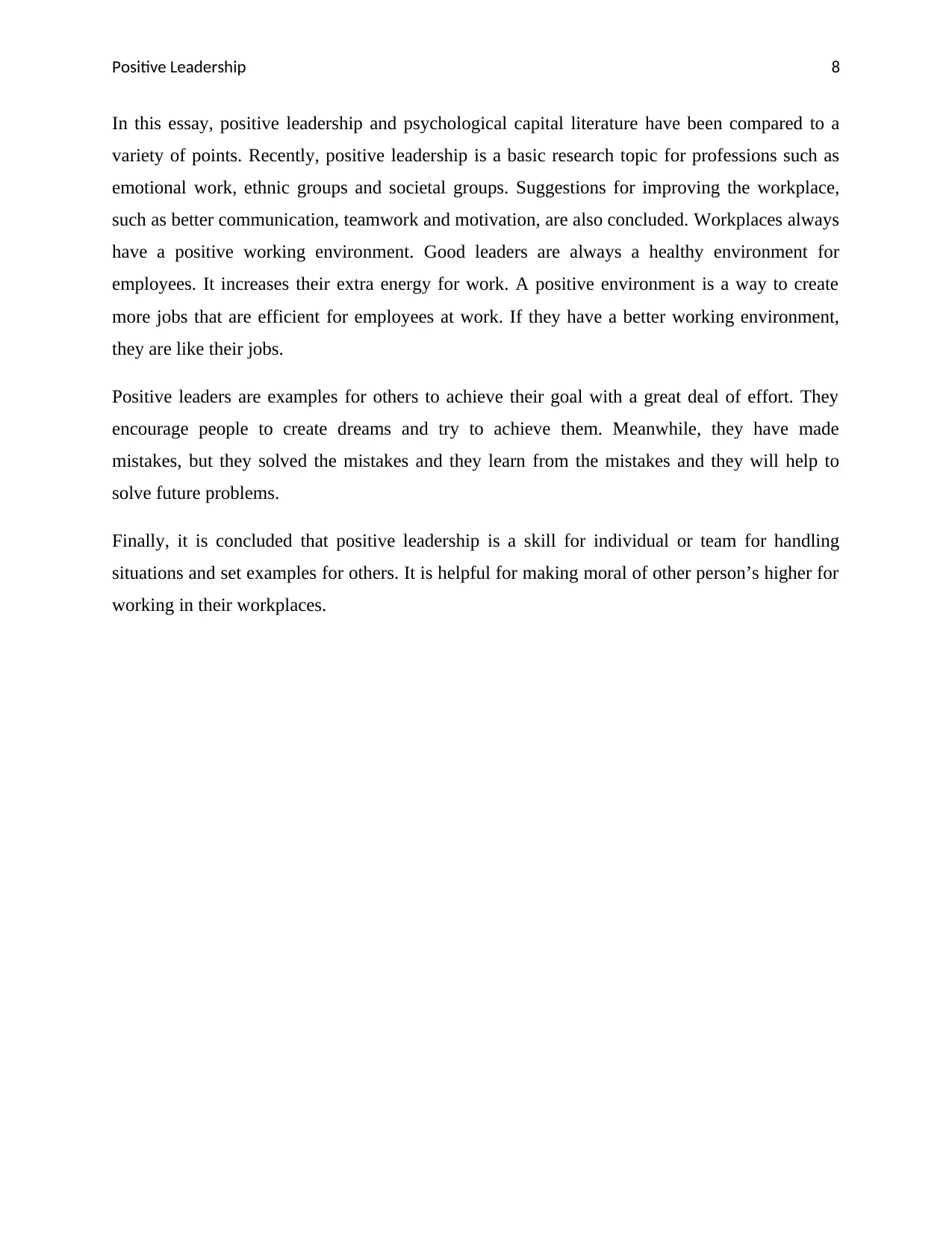
Positive Leadership 8
In this essay, positive leadership and psychological capital literature have been compared to a
variety of points. Recently, positive leadership is a basic research topic for professions such as
emotional work, ethnic groups and societal groups. Suggestions for improving the workplace,
such as better communication, teamwork and motivation, are also concluded. Workplaces always
have a positive working environment. Good leaders are always a healthy environment for
employees. It increases their extra energy for work. A positive environment is a way to create
more jobs that are efficient for employees at work. If they have a better working environment,
they are like their jobs.
Positive leaders are examples for others to achieve their goal with a great deal of effort. They
encourage people to create dreams and try to achieve them. Meanwhile, they have made
mistakes, but they solved the mistakes and they learn from the mistakes and they will help to
solve future problems.
Finally, it is concluded that positive leadership is a skill for individual or team for handling
situations and set examples for others. It is helpful for making moral of other person’s higher for
working in their workplaces.
In this essay, positive leadership and psychological capital literature have been compared to a
variety of points. Recently, positive leadership is a basic research topic for professions such as
emotional work, ethnic groups and societal groups. Suggestions for improving the workplace,
such as better communication, teamwork and motivation, are also concluded. Workplaces always
have a positive working environment. Good leaders are always a healthy environment for
employees. It increases their extra energy for work. A positive environment is a way to create
more jobs that are efficient for employees at work. If they have a better working environment,
they are like their jobs.
Positive leaders are examples for others to achieve their goal with a great deal of effort. They
encourage people to create dreams and try to achieve them. Meanwhile, they have made
mistakes, but they solved the mistakes and they learn from the mistakes and they will help to
solve future problems.
Finally, it is concluded that positive leadership is a skill for individual or team for handling
situations and set examples for others. It is helpful for making moral of other person’s higher for
working in their workplaces.
⊘ This is a preview!⊘
Do you want full access?
Subscribe today to unlock all pages.

Trusted by 1+ million students worldwide
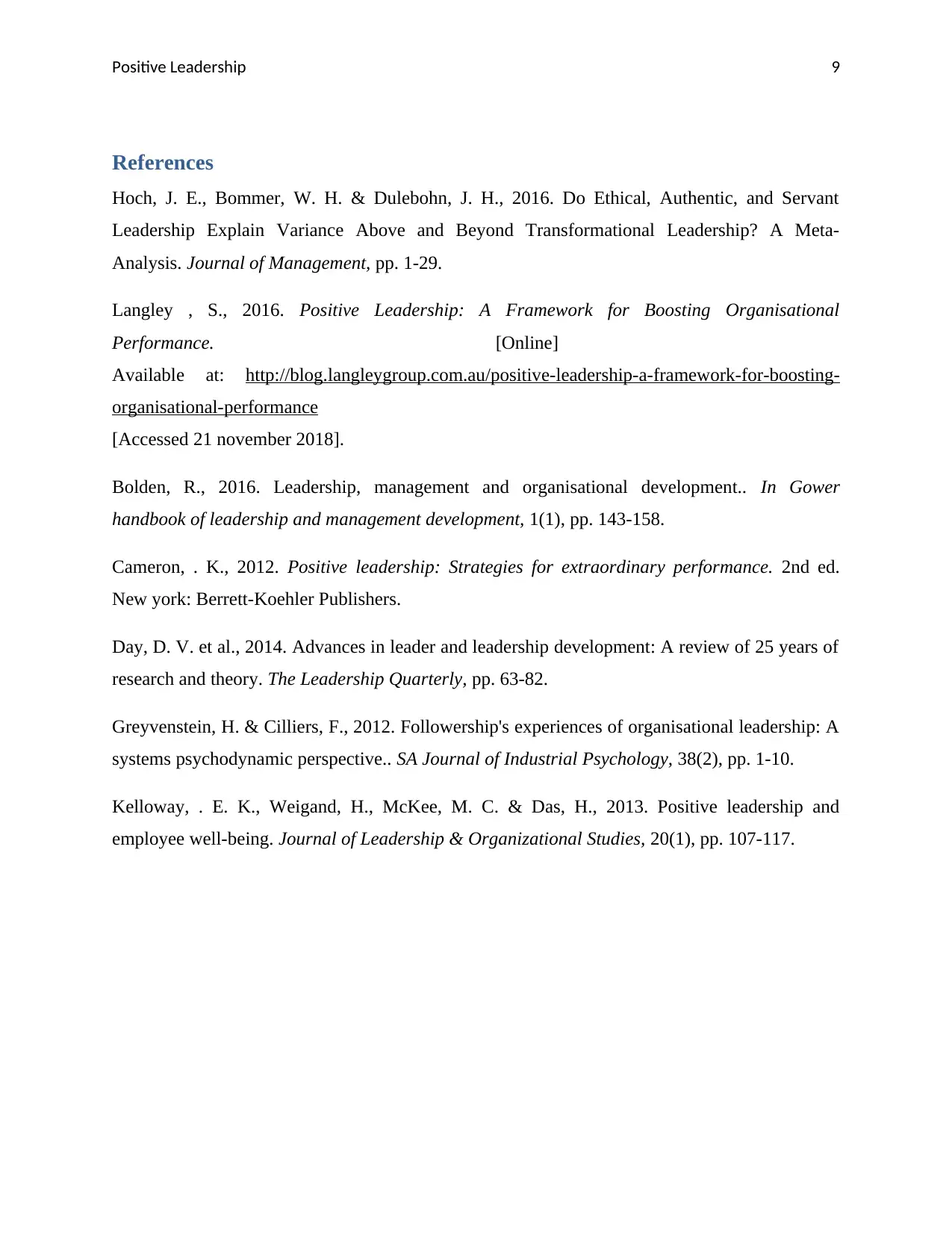
Positive Leadership 9
References
Hoch, J. E., Bommer, W. H. & Dulebohn, J. H., 2016. Do Ethical, Authentic, and Servant
Leadership Explain Variance Above and Beyond Transformational Leadership? A Meta-
Analysis. Journal of Management, pp. 1-29.
Langley , S., 2016. Positive Leadership: A Framework for Boosting Organisational
Performance. [Online]
Available at: http://blog.langleygroup.com.au/positive-leadership-a-framework-for-boosting-
organisational-performance
[Accessed 21 november 2018].
Bolden, R., 2016. Leadership, management and organisational development.. In Gower
handbook of leadership and management development, 1(1), pp. 143-158.
Cameron, . K., 2012. Positive leadership: Strategies for extraordinary performance. 2nd ed.
New york: Berrett-Koehler Publishers.
Day, D. V. et al., 2014. Advances in leader and leadership development: A review of 25 years of
research and theory. The Leadership Quarterly, pp. 63-82.
Greyvenstein, H. & Cilliers, F., 2012. Followership's experiences of organisational leadership: A
systems psychodynamic perspective.. SA Journal of Industrial Psychology, 38(2), pp. 1-10.
Kelloway, . E. K., Weigand, H., McKee, M. C. & Das, H., 2013. Positive leadership and
employee well-being. Journal of Leadership & Organizational Studies, 20(1), pp. 107-117.
References
Hoch, J. E., Bommer, W. H. & Dulebohn, J. H., 2016. Do Ethical, Authentic, and Servant
Leadership Explain Variance Above and Beyond Transformational Leadership? A Meta-
Analysis. Journal of Management, pp. 1-29.
Langley , S., 2016. Positive Leadership: A Framework for Boosting Organisational
Performance. [Online]
Available at: http://blog.langleygroup.com.au/positive-leadership-a-framework-for-boosting-
organisational-performance
[Accessed 21 november 2018].
Bolden, R., 2016. Leadership, management and organisational development.. In Gower
handbook of leadership and management development, 1(1), pp. 143-158.
Cameron, . K., 2012. Positive leadership: Strategies for extraordinary performance. 2nd ed.
New york: Berrett-Koehler Publishers.
Day, D. V. et al., 2014. Advances in leader and leadership development: A review of 25 years of
research and theory. The Leadership Quarterly, pp. 63-82.
Greyvenstein, H. & Cilliers, F., 2012. Followership's experiences of organisational leadership: A
systems psychodynamic perspective.. SA Journal of Industrial Psychology, 38(2), pp. 1-10.
Kelloway, . E. K., Weigand, H., McKee, M. C. & Das, H., 2013. Positive leadership and
employee well-being. Journal of Leadership & Organizational Studies, 20(1), pp. 107-117.
1 out of 10
Related Documents
Your All-in-One AI-Powered Toolkit for Academic Success.
+13062052269
info@desklib.com
Available 24*7 on WhatsApp / Email
![[object Object]](/_next/static/media/star-bottom.7253800d.svg)
Unlock your academic potential
Copyright © 2020–2025 A2Z Services. All Rights Reserved. Developed and managed by ZUCOL.




